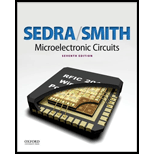
Microelectronic Circuits (The Oxford Series in Electrical and Computer Engineering) 7th edition
7th Edition
ISBN: 9780199339136
Author: Adel S. Sedra, Kenneth C. Smith
Publisher: Oxford University Press
expand_more
expand_more
format_list_bulleted
Concept explainers
Question
thumb_up100%
Chapter 1, Problem 1.17P
To determine
The value of the current through the resistor
Expert Solution & Answer
Want to see the full answer?
Check out a sample textbook solution
Students have asked these similar questions
Handwritten solution required do not use AI
Handwritten solution required not using chatgpt
Solve by Hand not using AI or chatgpt
Chapter 1 Solutions
Microelectronic Circuits (The Oxford Series in Electrical and Computer Engineering) 7th edition
Ch. 1.1 - Prob. 1.1ECh. 1.1 - Prob. 1.2ECh. 1.1 - Prob. 1.3ECh. 1.1 - Prob. 1.4ECh. 1.2 - Prob. 1.5ECh. 1.2 - Prob. 1.6ECh. 1.2 - Prob. 1.7ECh. 1.2 - Prob. 1.8ECh. 1.3 - Prob. 1.9ECh. 1.4 - Prob. 1.10E
Ch. 1.4 - Prob. 1.11ECh. 1.5 - Prob. 1.12ECh. 1.5 - Prob. 1.13ECh. 1.5 - Prob. 1.14ECh. 1.5 - Prob. 1.15ECh. 1.5 - Prob. 1.16ECh. 1.5 - Prob. 1.17ECh. 1.5 - Prob. 1.18ECh. 1.5 - Prob. 1.19ECh. 1.5 - Prob. 1.20ECh. 1.5 - Prob. 1.21ECh. 1.6 - Prob. 1.22ECh. 1.6 - Prob. D1.23ECh. 1.6 - Prob. D1.24ECh. 1 - Prob. 1.1PCh. 1 - Prob. 1.2PCh. 1 - Prob. 1.3PCh. 1 - Prob. 1.4PCh. 1 - Prob. 1.5PCh. 1 - Prob. 1.6PCh. 1 - Prob. 1.7PCh. 1 - Prob. D1.8PCh. 1 - Prob. D1.9PCh. 1 - Prob. 1.10PCh. 1 - Prob. D1.11PCh. 1 - Prob. D1.12PCh. 1 - Prob. D1.13PCh. 1 - Prob. 1.14PCh. 1 - Prob. 1.15PCh. 1 - Prob. 1.16PCh. 1 - Prob. 1.17PCh. 1 - Prob. 1.18PCh. 1 - Prob. 1.19PCh. 1 - Prob. 1.20PCh. 1 - Prob. 1.21PCh. 1 - Prob. 1.22PCh. 1 - Prob. 1.23PCh. 1 - Prob. 1.24PCh. 1 - Prob. 1.25PCh. 1 - Prob. 1.26PCh. 1 - Prob. 1.27PCh. 1 - Prob. 1.28PCh. 1 - Prob. 1.29PCh. 1 - Prob. 1.30PCh. 1 - Prob. 1.31PCh. 1 - Prob. 1.32PCh. 1 - Prob. 1.33PCh. 1 - Prob. 1.34PCh. 1 - Prob. 1.35PCh. 1 - Prob. 1.36PCh. 1 - Prob. 1.37PCh. 1 - Prob. 1.38PCh. 1 - Prob. 1.39PCh. 1 - Prob. 1.40PCh. 1 - Prob. 1.41PCh. 1 - Prob. 1.42PCh. 1 - Prob. 1.43PCh. 1 - Prob. 1.44PCh. 1 - Prob. 1.45PCh. 1 - Prob. 1.46PCh. 1 - Prob. 1.47PCh. 1 - Prob. 1.48PCh. 1 - Prob. D1.49PCh. 1 - Prob. D1.50PCh. 1 - Prob. D1.51PCh. 1 - Prob. D1.52PCh. 1 - Prob. 1.53PCh. 1 - Prob. 1.54PCh. 1 - Prob. 1.55PCh. 1 - Prob. 1.56PCh. 1 - Prob. D1.57PCh. 1 - Prob. 1.58PCh. 1 - Prob. D1.59PCh. 1 - Prob. D1.60PCh. 1 - Prob. D1.61PCh. 1 - Prob. D1.62PCh. 1 - Prob. 1.63PCh. 1 - Prob. 1.64PCh. 1 - Prob. 1.65PCh. 1 - Prob. 1.66PCh. 1 - Prob. 1.67PCh. 1 - Prob. 1.68PCh. 1 - Prob. 1.69PCh. 1 - Prob. D1.70PCh. 1 - Prob. 1.71PCh. 1 - Prob. 1.72PCh. 1 - Prob. 1.73PCh. 1 - Prob. 1.74PCh. 1 - Prob. D1.75PCh. 1 - Prob. D1.76PCh. 1 - Prob. 1.77PCh. 1 - Prob. 1.78PCh. 1 - Prob. D1.79PCh. 1 - Prob. 1.80PCh. 1 - Prob. 1.81P
Knowledge Booster
Learn more about
Need a deep-dive on the concept behind this application? Look no further. Learn more about this topic, electrical-engineering and related others by exploring similar questions and additional content below.Similar questions
- NO AI PLEASE.arrow_forward2-3) For each of the two periodic signals in the figures below, find the exponential Fourier series and sketch the magnitude and angle spectra. -5 ΟΙ 1 1- (a) (b) -20π -10x -π Π 10m 20m 1-arrow_forwardI need help with this problem and an explanation of the solution for the image described below. (Introduction to Signals and Systems)arrow_forward
- In the op-amp circuit shown in Fig. P8.32,uin(t) = 12cos(1000t) V,R = 10 k Ohm , RL = 5 k Ohm, and C = 1 μF. Determine the complexpower for each of the passive elements in the circuit. Isconservation of energy satisfied?arrow_forward2-4) Similar to Lathi & Ding prob. 2.9-4 (a) For signal g(t)=t, find the exponential Fourier series to represent g(t) over the interval(0, 1). (b) Sketch the original signal g(t) and the everlasting signal g'(t) represented by the same Fourier series. (c) Verify Parseval's theorem [eq. (2.103b)] for g'(t), given that: = n 1 6arrow_forward8.24 In the circuit of Fig. P8.24, is(t) = 0.2sin105t A,R = 20 W, L = 0.1 mH, and C = 2 μF. Show that the sum ofthe complex powers for the three passive elements is equal to thecomplex power of the source.arrow_forward
arrow_back_ios
SEE MORE QUESTIONS
arrow_forward_ios
Recommended textbooks for you
 Delmar's Standard Textbook Of ElectricityElectrical EngineeringISBN:9781337900348Author:Stephen L. HermanPublisher:Cengage Learning
Delmar's Standard Textbook Of ElectricityElectrical EngineeringISBN:9781337900348Author:Stephen L. HermanPublisher:Cengage Learning

Delmar's Standard Textbook Of Electricity
Electrical Engineering
ISBN:9781337900348
Author:Stephen L. Herman
Publisher:Cengage Learning
Multistage Transistor Audio Amplifier Circuit; Author: The Organic Chemistry Tutor;https://www.youtube.com/watch?v=LJrL9N9uhkE;License: Standard Youtube License